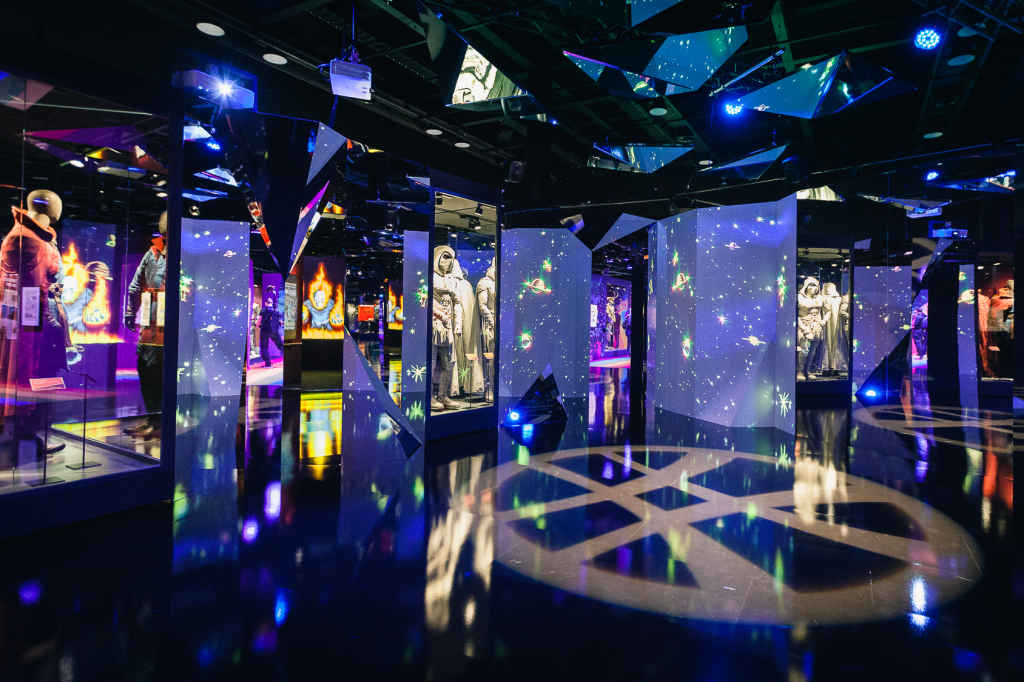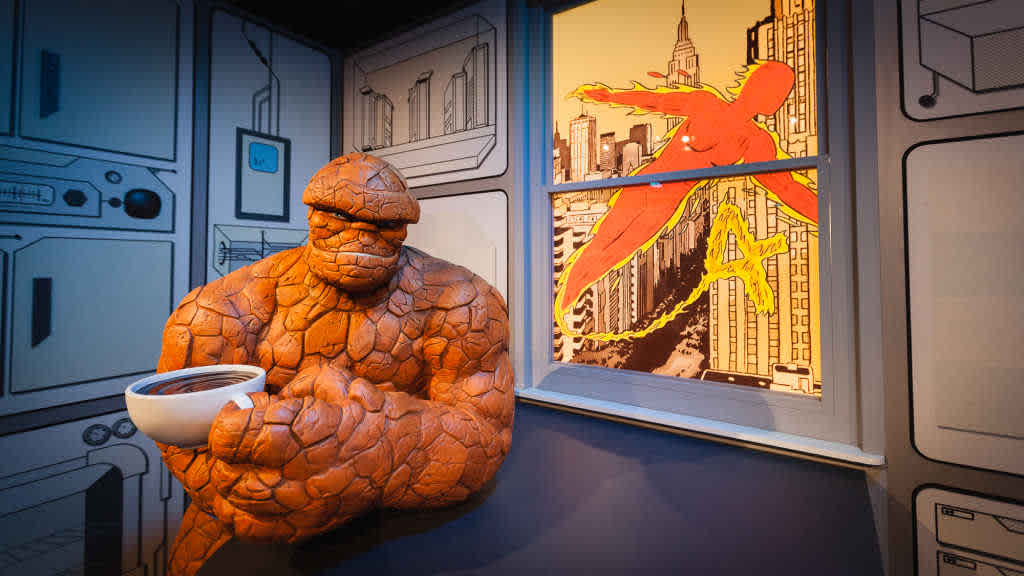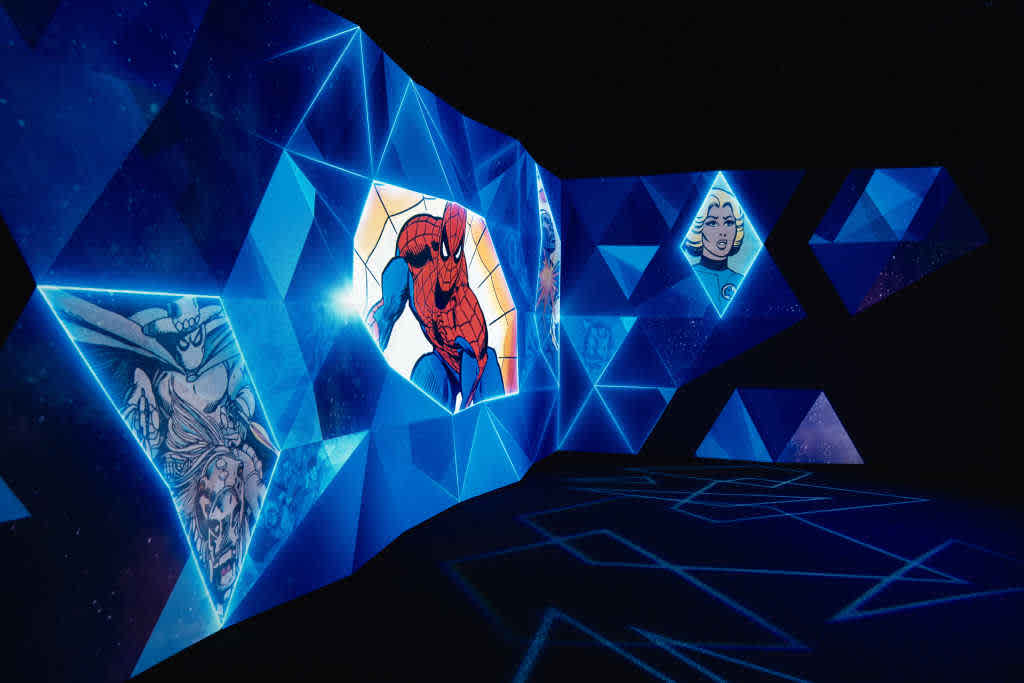A touring exhibition celebrating 70 years of Marvel Comics has fully embraced interactive technology to reach all ages. Paul Milligan reports.
Chances are if you’ve ever read a comic book in your life it was probably a Marvel one. For 85 years Marvel has created some of the best known superheroes of all time including Spider-Man, Hulk, Thor, Fantastic Four, Iron Man, X-Men and many more.
In December 2023, a new exhibition exploring the world of Marvel Comics by Semmel Exhibitions had its world premiere in Wellington, New Zealand. The next stop for the exhibition was the Odysseum in Cologne, Germany, where Marvel: The Exhibition – Universe of Super Heroes showcased over 200 rare and original artifacts, including authentic props and costumes from Marvel Studios as well as drawings and artworks by famous comic artists such as Stan Lee and Steve Ditko.

The exhibition has co-curators, Patrick A Reed and Ben Saunders, who were in charge of content, and bespoke audio was supplied by LEM Studios. Charged with the overall design and technical implementation of the exhibition was Studio TK, a Berlin-based design studio specialising in touring, permanent and brand exhibitions. It had worked with Semmel Exhibitions on previous projects and was hired here to pull together decades of content is a way that was digestible to both super fans and those with little previous comic book knowledge.
In Cologne superheroes fans will find 11 rooms packed with physical artefacts, memorabilia, video and graphic content, interactive touchscreens, lots of projection mapping and even a couple of Pepper’s Ghost installations. The rooms are themed and run in a rough chronological order. “A basic idea we had for the design of the exhibition was to make a walkable comic book, the idea is you can walk through a comic environment,” explains Annette Dooman, art director and concept designer, Studio TK. The thinking behind the design has been to mix media with physical objects and also with original art when applicable.
The first thing visitors experience is a 5-minute introductory video exploring the early history and development of Marvel Comics and its (many) iconic superheroes and villains. The first room is entitled ‘Origins’, among the colourful sights on display are a large Hulk sculpture bursting out the wall (perfect for a photo opportunity) and the first ever Marvel Comic book from 1939, now worth somewhere between $1-2 million. The output of three Epson 5,000 lumens projectors mix with graphic content on the walls, alongside 27-in video screens showing information on Dr Strange, Hulk and Spider-Man and the Human Torch amongst others.

The next room explores the Fantastic Four, highlights here include an interactive table next to a large sculpture of The Thing enjoying a morning coffee, “So people can take a photo with him or just hang out,” says Tobias Kunz, managing and creative director from Studio TK. Screens showing Sue Storm use a lenticular picture effect to showcase her superpower of invisibility, she appears, she disappears etc. The next room explores the world of Wakanda, and the Black Panther comic.
Here you will find the first use of Pepper’s Ghost technology and a perfect example of where Studio TK has blended the physical with the digital. In this case it has taken a prop directly from a Marvel movie, T’Chaka’s Kimoyo Beads (a technologically advanced form of communication), and blended it with Pepper’s Ghost effect to really bring it to life.

The same room then blends into a comic from Marvel’s early days, The Submariner. To illustrate the King of Atlantis (as he was also known) Studio TK has filed the room with aquatic images projected from top to bottom, “We wanted to achieve a situation where people really feel like they are underwater and fully immersed in it,” says Dooman.
The next room, splint into two, celebrates the iconic Spider-Man character. Technology here is split again between Epson projectors, Samsung 55-in screens and 27-in iiyama touchscreens.
The content shows the early years and development of Spiderman culminating into Spidey and his Amazing Friends (a TV cartoon for kids). In the second part there is an immersive installation featuring Miles Morales (a young variant of Spider-Man), which is part projection, part mirrored wall.
Kunz describes how it works; “When you’re standing next to or crouching next to Miles Morales it creates the impression you’re on top of a skyscraper with him looking down onto the city. We’ve created photo ops with three-dimensional sculptures so you are close to your heroes, you can touch them, you can be with them.”
The next room explores Captain America, who was the first Avenger, it then goes on to introduce the other Avengers too. This room features the Captain Ice exhibit, which is a clever mix of lighting and graphics and treated Plexiglas, to give the impression that Captain America is really frozen inside. This section also features the second use of Pepper’s Ghost, where a very tiny Ant-Man paces around a little box. This was born of the challenge to represent a superhero whose power is being able to shrink to the size of a small insect.
“How can we show Ant-Man? We chose Pepper’s Ghost. You see Ant-Man running around and The Wasp comes and give him a kiss. It’s an elevated showcase with little figures inside, and kids love it.”

The second part of the Avengers room features a two-sided Iron Man interactive exhibit which features a gesture tracking interactive where guests can stand in front of a screen and move their body and the Iron Man armour is applied to them. There is a duplicate of the interactive on the other side to stop long queues.
The next room is again split into two, looking at young superheroes and then exploring the art of Marvel Comics. In this room there are two interactive tables giving a deep dive into how comics are actually made, looking at different colour artists, different ink artists, visitors can try themselves to see the different effects of a thick or thin pen and different colours.
The next room explores X-Men and Mutants and features a large media installation called the Hellfire Gala, which is a fashion runway show highlighting the different costumes of the X-Men over the years. The next room, called ‘Bring On The Bad Guys’ salutes the many famous supervillains that have appeared in Marvel Comics.
In here touchscreens give information on villains, what their skills are and how big their egos are. To do this Studio TK’s media team has taken still images and subtly animated them to create short clips. In the Supernatural and Monsters Corner visitors can see an exhibit of the Ghost Rider character lit up in flames which features another mix of sound, graphics and projection mapping.

“I really like this one because this is a mix between graphic and projection mapping and the mapping really enhances what’s in there with the graphics, together with sound of crackling fire, and burning sounds,” says Dooman. One of the standout immersive exhibits in the show can be found in the Dr Strange gallery. “Not only is this whole gallery shaped very strangely but it’s full of mirrors so once you’re inside this gallery you can see artifacts but also see yourself and the projection multiple times and in different angles, it’s proven to be very effective,” says Kunz.
Visitors then cross the Rainbow Bridge to enter the Cosmic area, which is the last large gallery before the final section. It features projection mapping on the walls and on the floor, again the mapping wraps around artwork. The content is focused on the ‘Kirby Krackle’ (an illustrative technique used by famous comic artist Jack Kirby to show explosions, smoke, blasts from ray guns etc). Guest leave via the outro, and this room has the subtitle of the Multiverse. “We entered with lots of rectangular designs, here we have splintered designs, three blended projectors show the different entities of certain Marvel characters,” explains Dooman.

The music for the exhibition was composed and produced by Sebastian M. Purfürst (creative direction) and Markus “Hossi” Hossack (technical direction) of LEM-Studios, Berlin, who specialise in acoustic scenography and immersive sound installations. Commissioned to realise the artistic and technical concept of the immersive sound installation, Purfürst and Hossack developed a soundscape including 70 Genelec 4430 Smart IP networked loudspeakers that guide guests through the Marvel world.
“It’s important to understand where the highlights are in these shows, where the music and the sound effects are extremely important for the storytelling, and other moments when there should be a reduced level of intensity, people want to read something and take it in. Music is not necessarily as important then, it’s more for the atmosphere and less for the storytelling. We have to make sure it’s a dynamic experience and not just like an overkill of everything all at once, all the time,” says Purfürst.
This was a fun project to work on says Hossack, but once it had finished the studio production they faced some complex on-site challenges. “Reverberations and reflections caused problems, as well as sound spilling between galleries. We were also faced with very tight deadlines for set-up and on-site mixing. Additionally, the creation of a high-fidelity listening experience coupled with highly detailed audio events and the dramatic concept of the exhibition was also a challenge,” adds Hossack.

The audio elements play an important role in the whole exhibition, at the Captain Ice exhibit the sound crackles and emits eerie ambient drones. The surreal multiverse of Doctor Strange has spinning wormhole like sonic particle streams, and the dark back alleyways of New York City play out fragments of beats. The rainbow bridge seen in Avengers also has orchestral and vintage synthesiser sounds, all bespoke creations of Purfürst and Hossack. “The main responsibility as composers and sound designers is to serve the storytelling of the exhibition. We have to be aware of the atmosphere, the content, what’s actually presented, are there voiceovers? Are there additional sound effects from media installations? There’s a lot of elements coming together and we need to weave all of this into one musical fabric that actually makes sense for the overall experience,” explains Hossack.
Kit list
AirSelect PX-101 proximity sensor
Amphenol Audio Amphe-Dante adapters
Beetronics 13HD7M 13-in, 15TSV7M 15-in, 27HD7M 27-in displays
Behringer Mitropa HA 400 headphone amplifiers
Brightsign HD 1024, LS424, XD1024 media players
Elgato Stream Deck
Epson EB-1485Fi, EB-L630SU projectors
Genelec 4430A Smart IP loudspeakers
HeavyM mapping software
Heddier 1Z radar sensor
Hypervsn holographic human display
Iiyama ProLite TF2738MSC-B2, ProLite XU2390HS touchscreens
JBL Control 1 loudspeakers
Kramer TP-580T, TP-580R extenders
Samsung QM50B, QM32R-B 32-in, QM55B 55-in displays
Swissonic A306 active monitors
Thomann t.amp PM40X and PM40C amplifiers, The Box Achat 112A subwoofers
Ultraleap Stereo IR 170 gesture controller
Visaton EX80S electrodynamic exciter